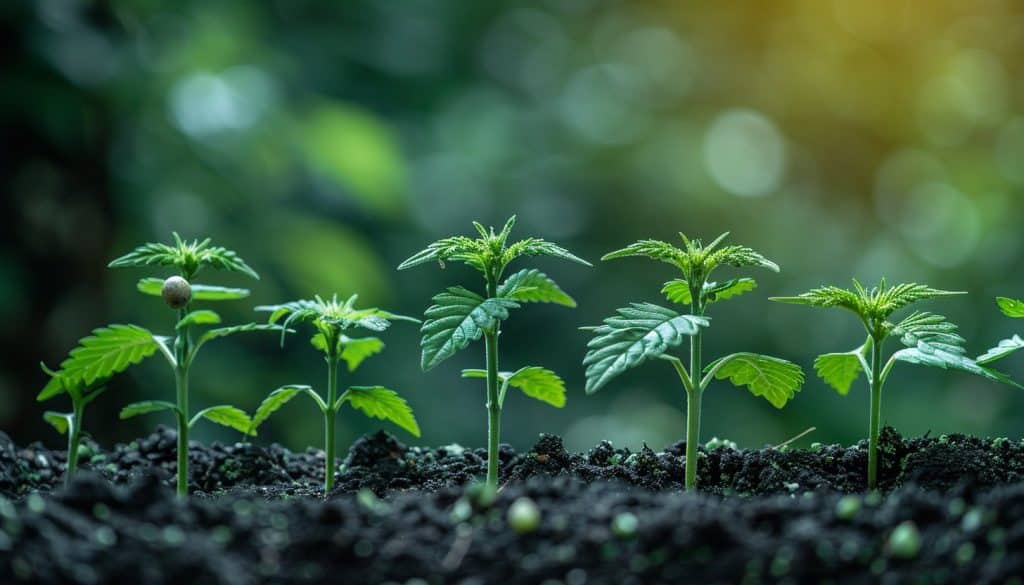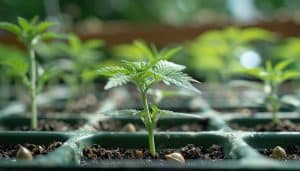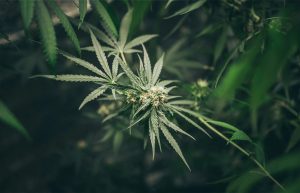The development of cannabis seeds intrigues both amateur and professional gardeners. This plant, famous for its diverse uses and its adaptation to different climates, follows a precise germination cycle before reaching maturity. Understanding the time required for each phase can help optimize the crop and ensure a better harvest.
Start of the journey: germination
Germination is the first crucial step in the life of a cannabis seed. This process typically begins when the seed is exposed to sufficient humidity, air, and a suitable temperature, usually between 20°C and 30°C. Activation of the seed results in the emergence of the rootlet and the first leaves, called cotyledons. The germination period may vary depending on environmental conditions but usually lasts between 24 hours And 7 days, after which the seedling begins to develop visibly.
Influence of external factors on germination
The results of this phase are strongly influenced by several environmental factors. The choice of substrate, whether earthy or not, as well as the humidity level and water quality, play a vital role. Cannabis seeds respond best to light but constant watering which avoids waterlogging of the soil while maintaining the hydration necessary to activate embryonic metabolism.
Seedling establishment
After germination, the young seedling begins to fortify its main infrastructure. During this period, which generally extends over two weeks, the small plant forms new leaves while expanding its roots. This is where active photosynthesis begins which will encourage the robust development of the plant. Adequate light, preferably in the blue spectrum during the vegetative growth phase, ensures good development of photosynthetic tissues.
Nutrition and first aid
During this rapid growth phase, nutrition plays a fundamental role. Young plants require essential nutrients like nitrogen, phosphorus and potassium, which are available in most commercial cannabis formulations. Maintaining a balanced watering routine without saturating the soil is crucial to preventing overwatering diseases and supporting healthy root growth.
Active growth and flowering
As the plant matures, it enters a more active growth phase, which can last several weeks up to several months. During this period, the plant’s frame expands, often reaching a few meters in height, under optimal conditions. The transition to the flowering phase is induced by a change in the light cycle, with fewer hours of daily light.
Manage the light cycle
To encourage the cannabis plantlet to flower, you must meticulously adapt the duration of exposure to light. Typically, the plant requires switching from a light regime of 18 hours of light to 12 hours to stimulate the start of flowering. This manipulation simulates seasonal changes, encouraging the plant to produce flowers.
Main mistakes to avoid for optimal growth
Each stage of cannabis seed development requires attention and precision. Avoiding some common mistakes helps promote uninterrupted, healthy growth.
- Overwatering: Roots need oxygen as much as water; too much water can lead to root rot.
- Poor light timing: Poor control of the light cycle can delay or disrupt the growth and flowering phases.
- Ignoring plant signals: Ignoring visual cues like yellowing leaves or wilting can indicate nutritional deficiencies or parasitic attacks.
In short, the growth time of a cannabis seed until its maturation varies greatly but each stage has its particularities which, if correctly managed, will ensure health and productivity of the crop. Carefully examining each phase from germination to flowering maturity gives growers the best chance of success.




